Happy Birthday, Arthur Q. Bryan!
A doorbell rings at a residence in the Midwest, and the all-too-trusting couple that resides inside welcomes their visitor with an enthusiastic “Come in!” I’ll keep you in suspense no longer: the couple is Fibber McGee & Molly (Jim and Marian Jordan), and it’s a good bet that the person on the other side of the door at 79 Wistful Vista is one of their many friends and neighbors stopping in for a brief visit and some guaranteed laughs. Since today marks the 117th birthday of character great Arthur Q. Bryan, let’s assume that it’s Doctor George Gamble, who will affectionately insult his friend McGee (“Look, wobblejaw…”) and reduce those of us eavesdropping to completely hysterical laughter.
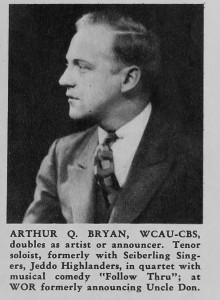 Born in Brooklyn, NY, Arthur demonstrated that marvelous sense of timing from the very moment the doctor gave him a smack on the rump to welcome him into the world. You see, by the time Bryan reached his twenties, radio was just starting to develop as a formidable entertainment medium…and he was indeed fortunate to be able to get in on the ground floor as an announcer at New York’s WEAF. Truth be told, Bryan’s ambitions were directed more toward singing in front of a microphone (he was a first-rate tenor, performing with such quartets as The Sieberling Singers). But announcing eventually became his forte. He filled in one day in 1929 for his friend Norman Brokenshire (when Norman experienced a bout of illness), and being in the right place at the right time soon landed him a plum position with Philadelphia’s WCAU in 1932.
Born in Brooklyn, NY, Arthur demonstrated that marvelous sense of timing from the very moment the doctor gave him a smack on the rump to welcome him into the world. You see, by the time Bryan reached his twenties, radio was just starting to develop as a formidable entertainment medium…and he was indeed fortunate to be able to get in on the ground floor as an announcer at New York’s WEAF. Truth be told, Bryan’s ambitions were directed more toward singing in front of a microphone (he was a first-rate tenor, performing with such quartets as The Sieberling Singers). But announcing eventually became his forte. He filled in one day in 1929 for his friend Norman Brokenshire (when Norman experienced a bout of illness), and being in the right place at the right time soon landed him a plum position with Philadelphia’s WCAU in 1932.
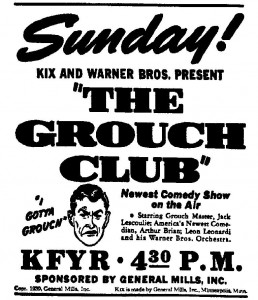 In 1938, Arthur Q. Bryan took in some California sun on vacation…and made the decision to stay permanently. He obtained work at the Warner Brothers-owned KFWB, and became a regular on that station’s comedy program The Grouch Club, described as a half-hour show about “life’s little annoyances.” (The program was written by Nat Hiken, later to become one of Fred Allen’s top scribes and the creator of TV’s The Phil Silvers Show and Car 54, Where are You?) The association between Warner’s and KFWB also led to a brief series of Grouch Club one-reelers, notably an entry entitled The Great Library Misery (1938) that makes the rounds on Turner Classic Movies from time to time. In addition, Bryan began appearing in bit roles in such films as Broadway Serenade (1939) and I Stole a Million (1939).
In 1938, Arthur Q. Bryan took in some California sun on vacation…and made the decision to stay permanently. He obtained work at the Warner Brothers-owned KFWB, and became a regular on that station’s comedy program The Grouch Club, described as a half-hour show about “life’s little annoyances.” (The program was written by Nat Hiken, later to become one of Fred Allen’s top scribes and the creator of TV’s The Phil Silvers Show and Car 54, Where are You?) The association between Warner’s and KFWB also led to a brief series of Grouch Club one-reelers, notably an entry entitled The Great Library Misery (1938) that makes the rounds on Turner Classic Movies from time to time. In addition, Bryan began appearing in bit roles in such films as Broadway Serenade (1939) and I Stole a Million (1939).
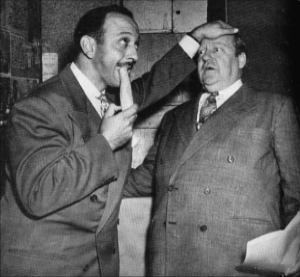 But the biggest benefit to being a member of the Warner Brothers family was that Arthur was pressed into service to provide voices for the characters that populated their animated cartoons. Director Tex Avery created an eccentric character named Egghead (modeled after comedian Joe Penner), and Arthur pronounced his “l’s” and “r’s” as “w’s” in classic baby talk fashion. Egghead soon morphed into Elmer Fudd, and with Elmer’s Candid Camera (1940), Arthur Q. Bryan would soon be working alongside the man who did most of the voices for the characters in the Warner’s stable: Mel Blanc. The Elmer Fudd voice was so versatile that Bryan borrowed it for use on The Fitch Bandwagon (then hosted by Dick Powell; Bryan was usually identified as “Waymond Wadcwiffe”) and many of the top radio comedy shows hosted by the likes of Al Pearce, Eddie Cantor and Rudy Vallee. Arthur Q. Bryan soon became one of radio’s most prominent second bananas, supporting Bud Abbott and Lou Costello, Jack Benny, Milton Berle, Bob Burns, George Burns and Gracie Allen, Cass Daley, Jimmy Durante, Charlotte Greenwood, Phil Harris and Alice Faye, Ken Murray, Dinah Shore, Red Skelton, and Bob Sweeney and Hal March.
But the biggest benefit to being a member of the Warner Brothers family was that Arthur was pressed into service to provide voices for the characters that populated their animated cartoons. Director Tex Avery created an eccentric character named Egghead (modeled after comedian Joe Penner), and Arthur pronounced his “l’s” and “r’s” as “w’s” in classic baby talk fashion. Egghead soon morphed into Elmer Fudd, and with Elmer’s Candid Camera (1940), Arthur Q. Bryan would soon be working alongside the man who did most of the voices for the characters in the Warner’s stable: Mel Blanc. The Elmer Fudd voice was so versatile that Bryan borrowed it for use on The Fitch Bandwagon (then hosted by Dick Powell; Bryan was usually identified as “Waymond Wadcwiffe”) and many of the top radio comedy shows hosted by the likes of Al Pearce, Eddie Cantor and Rudy Vallee. Arthur Q. Bryan soon became one of radio’s most prominent second bananas, supporting Bud Abbott and Lou Costello, Jack Benny, Milton Berle, Bob Burns, George Burns and Gracie Allen, Cass Daley, Jimmy Durante, Charlotte Greenwood, Phil Harris and Alice Faye, Ken Murray, Dinah Shore, Red Skelton, and Bob Sweeney and Hal March.
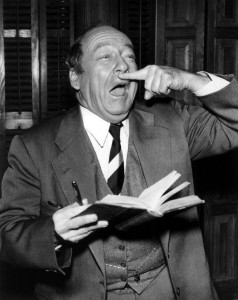 Arthur had a recurring role on Blondie as Mr. Fuddle, and would appear on such comedy programs as The Adventures of Maisie, Archie Andrews, My Favorite Husband, Life with Luigi, and The Mayor of the Town. Fittingly, as his comedy resume expanded, he would headline his own program: he performed the title role on Major Hoople, a 1942-43 NBC series based on the character from the popular comic strip Our Boarding House. (Arthur’s pal Mel Blanc played the part of star boarder Tiffany Twiggs.) One of the writers on the Hoople program, Phil Leslie, suggested to Fibber McGee & Molly head writer Don Quinn that Bryan would be an excellent addition to the program. (Phil had just landed a job on the show himself).
Arthur had a recurring role on Blondie as Mr. Fuddle, and would appear on such comedy programs as The Adventures of Maisie, Archie Andrews, My Favorite Husband, Life with Luigi, and The Mayor of the Town. Fittingly, as his comedy resume expanded, he would headline his own program: he performed the title role on Major Hoople, a 1942-43 NBC series based on the character from the popular comic strip Our Boarding House. (Arthur’s pal Mel Blanc played the part of star boarder Tiffany Twiggs.) One of the writers on the Hoople program, Phil Leslie, suggested to Fibber McGee & Molly head writer Don Quinn that Bryan would be an excellent addition to the program. (Phil had just landed a job on the show himself).
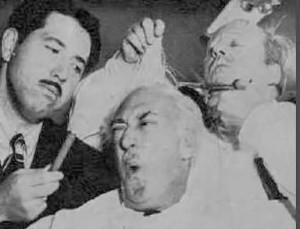 Bryan was certainly no stranger to working with Fibber and Molly (he had a bit part in their 1941 film Look Who’s Laughing). And once again, his timing was perfect. Two of the show’s regulars, Bill Thompson and Gale Gordon, were on extended leave due to their military service obligations in the war. Don and Phil created the character of George Gamble, a physician who filled in as McGee’s verbal sparring partner in the absence of Gordon’s Mayor LaTrivia (with a few echoes of the also-departed Throckmorton P. Gildersleeve). Doc Gamble, by virtue of his superior education, generally got the best of Fibber in their exchanges and he would soon be most welcomed by the show’s dedicated audience. At the same time, Arthur also played sardonic barber Floyd Munson on The Great Gildersleeve, the sitcom spun-off from the Fib & Molly show. (Mel Blanc played Floyd in early Gildersleeve broadcasts before Bryan settled in the part.)
Bryan was certainly no stranger to working with Fibber and Molly (he had a bit part in their 1941 film Look Who’s Laughing). And once again, his timing was perfect. Two of the show’s regulars, Bill Thompson and Gale Gordon, were on extended leave due to their military service obligations in the war. Don and Phil created the character of George Gamble, a physician who filled in as McGee’s verbal sparring partner in the absence of Gordon’s Mayor LaTrivia (with a few echoes of the also-departed Throckmorton P. Gildersleeve). Doc Gamble, by virtue of his superior education, generally got the best of Fibber in their exchanges and he would soon be most welcomed by the show’s dedicated audience. At the same time, Arthur also played sardonic barber Floyd Munson on The Great Gildersleeve, the sitcom spun-off from the Fib & Molly show. (Mel Blanc played Floyd in early Gildersleeve broadcasts before Bryan settled in the part.)
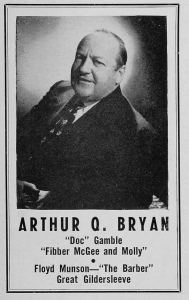 Bryan’s association with Don Quinn would even extend to a few appearances on Quinn’s other radio concoction, The Halls of Ivy (as Professor Warren). By the time Arthur worked on Ivy, he was demonstrating greater acting range by performing on such crime dramas as The Adventures of Philip Marlowe, The Adventures of the Saint, Jeff Regan, Investigator, The Man from Homicide, and Rocky Jordan. In fact, for a brief time he even took over for Ed Begley as Lt. Walter “Walt” Levinson on Dick Powell’s Richard Diamond, Private Detective. (When Bryan joined the program, Powell’s Diamond started to develop a repertoire of “fat” jokes). It would be impossible to list every one of Arthur Q. Bryan’s radio jobs, but a good start would include The Cavalcade of America, The Columbia Workshop, Favorite Story, The First Nighter Program, The Ford Theatre, The Lux Radio Theatre, The NBC University Theatre, Radio City Playhouse, The Railroad Hour, The Roy Rogers Show, The Screen Guild Theatre, Screen Director’s Playhouse, and Theater of Romance.
Bryan’s association with Don Quinn would even extend to a few appearances on Quinn’s other radio concoction, The Halls of Ivy (as Professor Warren). By the time Arthur worked on Ivy, he was demonstrating greater acting range by performing on such crime dramas as The Adventures of Philip Marlowe, The Adventures of the Saint, Jeff Regan, Investigator, The Man from Homicide, and Rocky Jordan. In fact, for a brief time he even took over for Ed Begley as Lt. Walter “Walt” Levinson on Dick Powell’s Richard Diamond, Private Detective. (When Bryan joined the program, Powell’s Diamond started to develop a repertoire of “fat” jokes). It would be impossible to list every one of Arthur Q. Bryan’s radio jobs, but a good start would include The Cavalcade of America, The Columbia Workshop, Favorite Story, The First Nighter Program, The Ford Theatre, The Lux Radio Theatre, The NBC University Theatre, Radio City Playhouse, The Railroad Hour, The Roy Rogers Show, The Screen Guild Theatre, Screen Director’s Playhouse, and Theater of Romance.
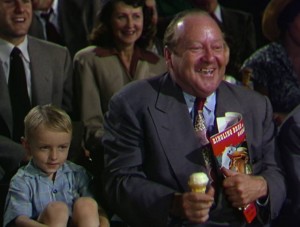 His work in radio—not to mention voicing Elmer Fudd—kept Arthur Q. Bryan pretty busy, so seeing him pop up in small roles in such films as Road to Singapore (1940), Larceny, Inc. (1942), Samson and Delilah (1949), and The Greatest Show on Earth (1952) is always a treat. Bryan tried to make time for the small screen as well, with guest shots on the likes of I Love Lucy, Our Miss Brooks, The People’s Choice and The Life of Riley. Animation fans would sadly discover, however, how integral Arthur was to the success of Elmer Fudd in the Warner Brothers cartoons when the actor passed away on November 18, 1959. Though Hal Smith, and even Mel Blanc, attempted to fill the void by doing Elmer’s voice…it just wasn’t the same. “Arthur was Elmer Fudd,” declared Mel’s son Noel.
His work in radio—not to mention voicing Elmer Fudd—kept Arthur Q. Bryan pretty busy, so seeing him pop up in small roles in such films as Road to Singapore (1940), Larceny, Inc. (1942), Samson and Delilah (1949), and The Greatest Show on Earth (1952) is always a treat. Bryan tried to make time for the small screen as well, with guest shots on the likes of I Love Lucy, Our Miss Brooks, The People’s Choice and The Life of Riley. Animation fans would sadly discover, however, how integral Arthur was to the success of Elmer Fudd in the Warner Brothers cartoons when the actor passed away on November 18, 1959. Though Hal Smith, and even Mel Blanc, attempted to fill the void by doing Elmer’s voice…it just wasn’t the same. “Arthur was Elmer Fudd,” declared Mel’s son Noel.
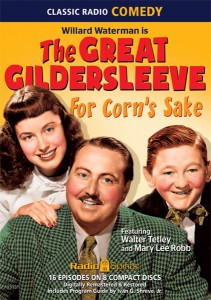 To celebrate Arthur Q. Bryan’s natal anniversary, Radio Spirits recommends sampling some of the actor’s signature roles…as Doc Gamble in our Fibber McGee & Molly collections Wistful Vista and For Goodness Sakes, and as Floyd Munson in The Great Gildersleeve sets Marjorie’s Wedding, Neighbors, and For Corn’s Sakes. In addition, Bryan emotes as Lt. Levinson in the Richard Diamond, Private Detective compendiums Dead Men, Homicide Made Easy, Mayhem is My Business, and Shamus. Check out Arthur in Jeff Regan, Investigator (Stand by For Mystery) and The Man from Homicide, too!
To celebrate Arthur Q. Bryan’s natal anniversary, Radio Spirits recommends sampling some of the actor’s signature roles…as Doc Gamble in our Fibber McGee & Molly collections Wistful Vista and For Goodness Sakes, and as Floyd Munson in The Great Gildersleeve sets Marjorie’s Wedding, Neighbors, and For Corn’s Sakes. In addition, Bryan emotes as Lt. Levinson in the Richard Diamond, Private Detective compendiums Dead Men, Homicide Made Easy, Mayhem is My Business, and Shamus. Check out Arthur in Jeff Regan, Investigator (Stand by For Mystery) and The Man from Homicide, too!

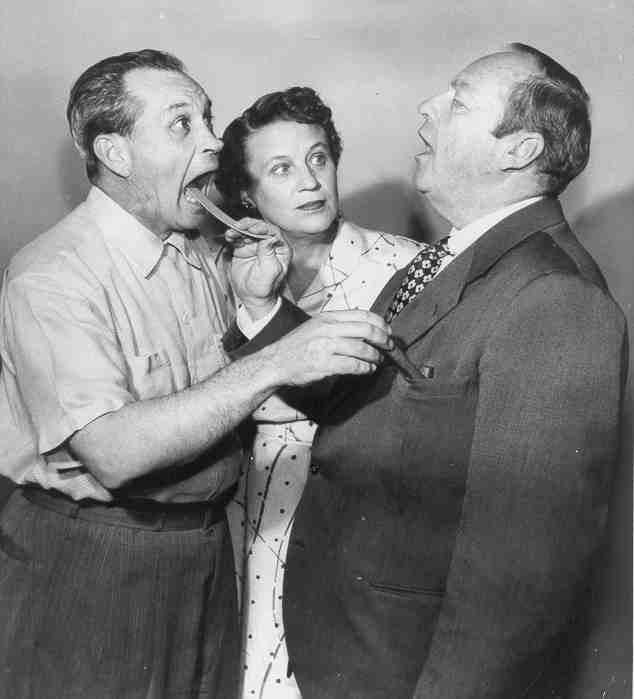

Discounted The Eddie Cantor Radio Show 194243
[…] ard singing in front of a microphone (he was a first-rate tenor, performing with […]
Arthur Q. Bryan is a big man.